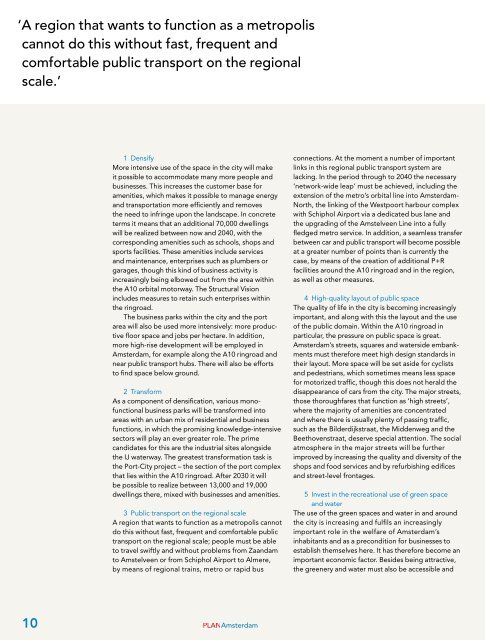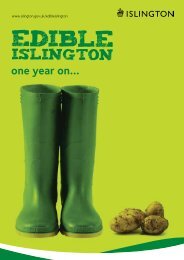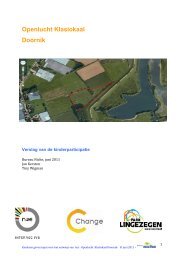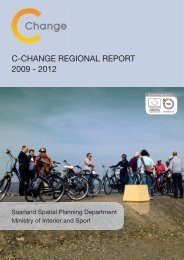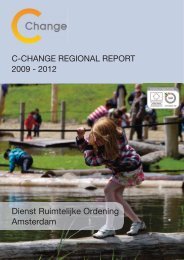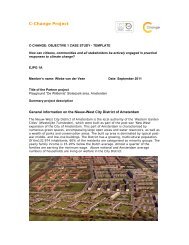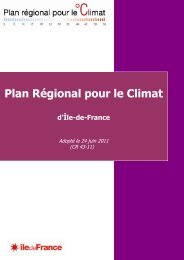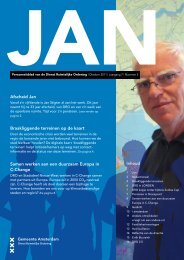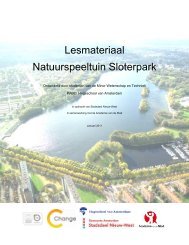Amsterdam 2040
Amsterdam 2040
Amsterdam 2040
- No tags were found...
Create successful ePaper yourself
Turn your PDF publications into a flip-book with our unique Google optimized e-Paper software.
‘A region that wants to function as a metropoliscannot do this without fast, frequent andcomfortable public transport on the regionalscale.’1 DensifyMore intensive use of the space in the city will makeit possible to accommodate many more people andbusinesses. This increases the customer base foramenities, which makes it possible to manage energyand transportation more efficiently and removesthe need to infringe upon the landscape. In concreteterms it means that an additional 70,000 dwellingswill be realized between now and <strong>2040</strong>, with thecorresponding amenities such as schools, shops andsports facilities. These amenities include servicesand maintenance, enterprises such as plumbers orgarages, though this kind of business activity isincreasingly being elbowed out from the area withinthe A10 orbital motorway. The Structural Visionincludes measures to retain such enterprises withinthe ringroad.The business parks within the city and the portarea will also be used more intensively: more productivefloor space and jobs per hectare. In addition,more high-rise development will be employed in<strong>Amsterdam</strong>, for example along the A10 ringroad andnear public transport hubs. There will also be effortsto find space below ground.2 TransformAs a component of densification, various monofunctionalbusiness parks will be transformed intoareas with an urban mix of residential and businessfunctions, in which the promising knowledge-intensivesectors will play an ever greater role. The primecandidates for this are the industrial sites alongsidethe IJ waterway. The greatest transformation task isthe Port-City project – the section of the port complexthat lies within the A10 ringroad. After 2030 it willbe possible to realize between 13,000 and 19,000dwellings there, mixed with businesses and amenities.3 Public transport on the regional scaleA region that wants to function as a metropolis cannotdo this without fast, frequent and comfortable publictransport on the regional scale; people must be ableto travel swiftly and without problems from Zaandamto Amstelveen or from Schiphol Airport to Almere,by means of regional trains, metro or rapid busconnections. At the moment a number of importantlinks in this regional public transport system arelacking. In the period through to <strong>2040</strong> the necessary‘network-wide leap’ must be achieved, including theextension of the metro’s orbital line into <strong>Amsterdam</strong>-North, the linking of the Westpoort harbour complexwith Schiphol Airport via a dedicated bus lane andthe upgrading of the Amstelveen Line into a fullyfledged metro service. In addition, a seamless transferbetween car and public transport will become possibleat a greater number of points than is currently thecase, by means of the creation of additional P+Rfacilities around the A10 ringroad and in the region,as well as other measures.4 High-quality layout of public spaceThe quality of life in the city is becoming increasinglyimportant, and along with this the layout and the useof the public domain. Within the A10 ringroad inparticular, the pressure on public space is great.<strong>Amsterdam</strong>’s streets, squares and waterside embankmentsmust therefore meet high design standards intheir layout. More space will be set aside for cyclistsand pedestrians, which sometimes means less spacefor motorized traffic, though this does not herald thedisappearance of cars from the city. The major streets,those thoroughfares that function as ‘high streets’,where the majority of amenities are concentratedand where there is usually plenty of passing traffic,such as the Bilderdijkstraat, the Middenweg and theBeethovenstraat, deserve special attention. The socialatmosphere in the major streets will be furtherimproved by increasing the quality and diversity of theshops and food services and by refurbishing edificesand street-level frontages.5 Invest in the recreational use of green spaceand waterThe use of the green spaces and water in and aroundthe city is increasing and fulfils an increasinglyimportant role in the welfare of <strong>Amsterdam</strong>’sinhabitants and as a precondition for businesses toestablish themselves here. It has therefore become animportant economic factor. Besides being attractive,the greenery and water must also be accessible and10PLAN<strong>Amsterdam</strong>


